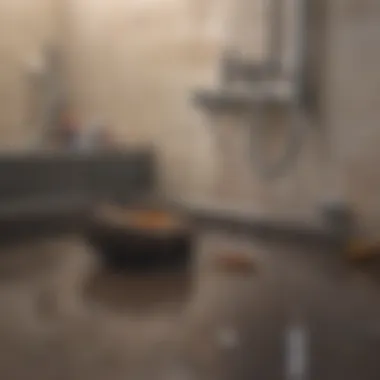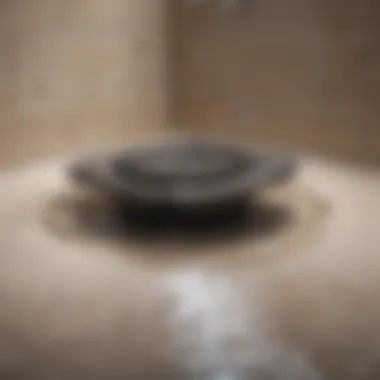Unclog Your Shower Drain: Effective Solutions


Intro
Dealing with a clogged shower drain can be quite frustrating. It's an issue many homeowners encounter, and understanding effective methods to address it is crucial. Clogs can lead to unpleasant odors, unsightly pooling of water, and potentially costly repairs if not managed promptly. In this article, we will explore actionable techniques to unblock your shower drain efficiently. From common household remedies to professional tools, you will discover various methods ensuring optimum performance of your shower system.
Equipping yourself with knowledge about the underlying causes of drain clogs and how to prevent them is equally important. In the end, our goal is to keep your shower functional and reducing maintenance hassles in the future.
Prelims to Shower Drain Blockages
Understanding shower drain blockages is important for both homeowners and tenants. Regularly functioning drains contribute significantly to hygiene and comfort in the bathroom. When drains become blocked, it can lead to unpleasant odors and standing water, which pose health risks. Furthermore, acknowledging shower drain issues helps avoid costly repairs or professional interventions due to severe clogs.
Understanding Common Causes of Clogs
Shower drains often face blockages due to several factors that accumulate over time. A primary cause is hair. Human hair can easily gather in the drain, creating a barrier that prevents water from flowing freely. Soap residue also plays a significant role, as it builds up along with hair, forming a thick sludge that further restricts water passage.
Additionally, the type of shower products used can accelerate clogging. Heavy conditioners and certain body washes contain ingredients that, when mixed with water, can leave deposits in the pipes. Environmental elements, like small debris and dust, can enter the drain and compound existing issues.
Taking the time to understand these causes is crucial. By doing so, homeowners can be more proactive in managing their shower drainage system.
Importance of Regular Drain Maintenance
Regular drain maintenance cannot be understated if one wishes to ensure a consistently clear path for water flow. It involves simple practices such as cleaning the drain cover and removing hair routinely, which can significantly decrease the likelihood of blockages. Ignoring these small tasks can lead to bigger problems down the line.
Establishing a regular maintenance schedule for one's shower drain fosters better hygiene and efficiency. It creates an environment where clogs are less likely to form, thus preventing emergency situations. Many people still overlook this aspect, thinking that once clogs appear, they will easily resolve themselves.
"An ounce of prevention is worth a pound of cure."
Instead, taking proactive measures will save time and money in the long run. A small effort in maintenance can yield substantial benefits, keeping drains functional and minimizing unexpected hassles.
Initial Assessment of the Problem
Assessing an issue with your shower drain is the crucial first step to managing blockages. Understanding what is wrong with the drainage system can save time and avoid unnecessary frustrations. It provides clarity on which solutions may be most effective. The process includes examining symptoms of the blockage and determining its specific location.
Identifying Symptoms of a Blocked Drain
Recognizing the symptoms of a blocked drain is essential for prompt action. Common indicators include:
- Slow Drainage: Water takes longer than usual to go down the drain.
- Unpleasant Odors: Foul smells often arise from stagnant water or decomposing material.
- Gurgling Sounds: Unusual noises can occur when air is trapped in the pipes.
- Water Pooling: Water collects around your feet while you shower, indicating a blockage in the drain.
These symptoms often escalate if not addressed. A slow drain may progress to a completely blocked shower, making immediate action necessary.
Determining the Location of the Blockage
Finding the exact location of the blockage helps in choosing the right method for alleviating the problem. Blockages can occur in several areas:
- Drain Trap: Often found directly under the shower, this is a common spot for hair and soap scum to accumulate.
- Pipes: The connecting pipes may have build-up further along.
- Main Drain Line: Sometimes issues are in the main line, which may require professional assistance.
By identifying the specific area affected, you can select the most appropriate tools and techniques for unblocking your shower drain. For example, if the blockage is in the trap, a plunger or snake may be effective. However, if it’s deeper in the pipes, a more involved method or professional help may be needed.


DIY Solutions for Unblocking Shower Drains
Addressing shower drain blockages through DIY solutions holds significant value for homeowners. It allows individuals to tackle the problem promptly without the immediate need for professional assistance. This not only saves money but also equips homeowners with skills for future occurrences. Knowing how to efficiently clear your shower drain can minimize water damage and ensure the ongoing functionality of your plumbing system.
Moreover, opting for DIY methods often involves readily available materials. Many households have common items like plungers, baking soda, and vinegar on hand. This makes these methods both cost-effective and convenient. However, consideration for the type of blockage is crucial; not all methods may be effective for every scenario.
Using a Plunger Effectively
A plunger is a basic tool, yet, it plays a critical role in unblocking shower drains. To utilize it effectively, position the cup over the drain, ensuring a tight seal. Next, apply steady pressure with a firm up and down motion. This creates a suction effect that can dislodge debris causing the blockage. It’s essential to keep enough water in the shower to cover the cup, as this aids in the formation of the seal.
There are some factors to keep in mind:
- Type of Plunger: A flange plunger, with an extended rubber part, can be particularly effective for drains due to its design.
- Technique: Maintain controlled pressure to avoid damaging the drainage pipes or creating additional leaks.
- Repetition: Sometimes, multiple attempts are necessary before clearing the blockage.
Employing Baking Soda and Vinegar
Using baking soda and vinegar is a well-known home remedy that capitalizes on a chemical reaction. Begin by pouring approximately one cup of baking soda into the drain. Follow this with a cup of vinegar. The mixture bubbles, helping to dislodge debris and build-up lodged within the pipes. Wait for about 30 minutes, then flush the drain with hot water to rinse the remaining particles.
This method is beneficial due to its:
- Eco-friendliness: Baking soda and vinegar are safer alternatives compared to harsh chemical cleaners.
- Ease of Use: Most households already have these ingredients, which makes the process straightforward.
- Preventive Qualities: Regular use can help minimize the chances of future clogs.
Utilizing a Drain Snake
A drain snake, also known as a plumber's auger, is another effective tool for clearing stubborn clogs. This tool consists of a long, flexible metal wire with a spiral tip. To use it, insert one end into the drain and rotate the handle to push the snake deeper into the pipe. When resistance is met, rotate it further to break up or grab the blockage.
Some key considerations include:
- Manual vs. Powered Snakes: Manual options are suitable for most household blockages, while powered versions can address more severe clogs.
- Caution: Be gentle during the process. Excessive force may cause pipe damage.
- Follow-Up: After using the snake, running hot water through the drain will help eliminate any residual debris from the unclogging process.
Using these DIY methods can significantly enhance your ability to maintain and troubleshoot your shower drain effectively, leading to a better experience in your daily routines.
Chemical Remedies for Stubborn Clogs
Handling stubborn clogs often requires a more aggressive approach than physical tools or DIY remedies can provide. Chemical remedies can effectively dissolve built-up materials like hair, soap scum, and grease. These solutions offer several advantages. They often penetrate deep into the clog, addressing the root cause rather than just the surface symptoms.
However, it is essential to use these remedies judiciously, as improper use can lead to further issues, such as damage to your plumbing. Understanding the balance between efficacy and safety is crucial.
Commercial Drain Cleaners: Pros and Cons
Commercial drain cleaners are readily available in stores. They come in various formulations, including liquid, gel, and foam. Here are some pros and cons to consider:
Pros:
- Effectiveness: Many commercial cleaners can dissolve tough blockages quickly.
- Convenience: They are easy to use and require minimal setup.
- Variety: Available for different types of clogs.
Cons:


- Chemical Damage: Some formulations may harm older pipes or septic systems.
- Health Risks: The fumes and ingredients can be hazardous if inhaled or if they come into contact with the skin.
- Temporary Solution: They don’t always address the underlying issues that may contribute to future clogs.
Safety Precautions When Using Chemicals
Using chemical drain cleaners requires careful attention to safety. Here are some essential precautions:
- Read Instructions: Always follow the manufacturer's instructions carefully.
- Wear Protective Gear: Use gloves and goggles to prevent contact with skin and eyes.
- Ensure Proper Ventilation: Open windows or turn on fans to avoid inhaling fumes.
- Avoid Mixing Chemicals: Do not mix different brands or types of cleaners, as this can create harmful reactions.
- Store Safely: Keep products out of reach of children and pets.
The safe and effective use of chemical remedies can mitigate a blockage issue, but caution is paramount.
By understanding the strengths and limitations of chemical remedies, you can make an informed decision on the best approach for your shower drain. Awareness about safety and proper application can lead to effective results while minimizing risks.
When to Call a Professional Plumber
There are instances where the best DIY efforts may not be sufficient to resolve a persistent shower drain blockage. In these cases, engaging a professional plumber becomes not just a choice, but a necessity. Understanding when to make that call can save time, money, and frustration.
Recognizing Red Flags in Drain Blockages
Identifying specific indicators can help determine if it is time to consult an expert. Some common red flags include:
- Continuous gurgling sounds from the drain, despite attempts to clear it.
- Foul odors emanating from the shower area, hinting at trapped waste.
- Slow drainage that does not improve with DIY methods over time.
- Backflow of water or sewage, which signals serious plumbing issues.
If you notice any of these symptoms, it's prudent to seek professional assistance to prevent further complications.
Ignoring these signs can lead to more severe problems, such as pipe damage or water leaks, which can ultimately result in costly repairs.
Evaluating Costs vs. DIY Solutions
Analyzing the financial aspect of calling a plumber versus handling the issue independently is crucial. Consider the following factors:
- Nature of the Blockage: Simple clogs might be resolved through common methods at home.
- Risk of Damage: DIY attempts can unintentionally cause more harm than good, especially if dealing with old or fragile plumbing.
- Frequency of Issues: If blockages are recurrent, professional evaluation might uncover underlying problems that require specialist attention.
Before deciding:
- Calculate the potential cost of hiring a plumber versus the risks associated with continuing DIY solutions.
- Sometimes, paying for professional expertise can ultimately save money by preventing future issues.
In summary, knowing when to call a professional is a wise decision that can ensure the longevity and reliability of your shower drainage system.
Preventive Measures for Future Blockages
Preventive measures are crucial in maintaining a clear and functional shower drain. Clogs can be a significant inconvenience and often lead to costly repairs if not addressed early. Implementing preventative steps can save time, reduce stress, and improve the longevity of your plumbing system. It is essential to understand that most shower drain blockages originate from hair, soap residues, and other debris that accumulate over time. Thus, being proactive can minimize these issues.
Installing Drain Screens
Installing drain screens is one of the most effective preventive measures you can take. These devices are designed to catch larger debris such as hair and soap scum before they enter the drain. They are generally easy to install and can be found at most home improvement stores. The benefits of using drain screens include:
- Cost-Effective Solution: Screens are relatively inexpensive and can reduce the need for extensive cleaning or professional help.
- Ease of Use: They can be easily removed for cleaning, ensuring you maintain a clear drain.
- Versatility: Available in various sizes and designs, screens can fit almost any shower drain.


To install a drain screen, simply place it over the drain. Ensure it fits snugly to avoid any gaps where debris can escape. Regularly check and clean the screen to maximize its effectiveness.
Regular Cleaning Practices
Establishing a routine cleaning practice can significantly decrease the likelihood of future clogs. Simple tasks can make a difference in the overall health of your shower drain. Here are some recommended practices:
- Weekly Hair Removal: After each shower, take a moment to remove visible hair from the drain. This simple act can prevent accumulation over time.
- Monthly Deep Cleaning: Use a mixture of baking soda and vinegar monthly to help break down any soap scum or grease buildup. Pour half a cup of baking soda followed by half a cup of vinegar down the drain. Allow it to sit for about 30 minutes before rinsing with hot water. This method can enhance the flow of water and prevent potential blockages.
- Avoiding Chemical Products: While many chemicals are available to clean drains, their regular use can damage pipes over time. Opt for natural methods where possible.
Maintaining Your Shower Drain System
Maintaining your shower drain system is essential to ensure a smooth and efficient drainage process. Regular upkeep not only prevents clogs but also extends the life of your plumbing. Neglected drains can lead to various problems, including unpleasant odors, slow drainage, and water damage.
The benefits of a well-maintained shower drain are manifold. First, it enhances the functionality of your shower. A clean drain prevents the accumulation of hair, soap scum, and debris, which can contribute to blockages. Second, it promotes a healthier environment. Stagnant water due to poor drainage can attract pests and foster mold growth. Lastly, by investing time in maintenance, you might avoid costly repairs or professional plumbing services later.
Here are some key considerations when maintaining your shower drain system:
- Routine Cleaning: Regularly remove any visible debris and clean the strainer or grate.
- Assess Water Flow: Periodically check how quickly water drains to identify potential issues early.
- Use Preventative Additives: Consider safe, biologically-based enzymes or natural cleaning solutions to prevent buildup.
In summary, a proactive approach towards maintaining your shower drain can lead to less hassle and greater peace of mind. By embracing a few simple practices, you create a healthier home environment and safeguard your plumbing system.
Creating a Drain Maintenance Schedule
A drain maintenance schedule is an effective tool for ensuring your shower drains remain clear and functional. Having set intervals for checking and cleaning your drains can help avoid the frustration of sudden blockages. Here are some steps to establish a successful schedule:
- Determine Frequency: Evaluate your household's needs. A family with multiple members may require monthly checks, while a single-person household could opt for bimonthly.
- Set Reminders: Use a calendar or a reminder app to notify you of maintenance tasks. Regular alerts can help you develop a habit.
- Log Maintenance Tasks: Maintain a record of what has been cleaned and any observed issues. This can help identify patterns over time.
Monitoring Water Flow Patterns
Monitoring water flow patterns in your shower drains is vital for catching problems early. Observing how quickly and evenly water drains can provide insights into potential blockages. Some practical methods to monitor your drain's performance include:
- Visual Checks: Observe the flow pattern when using the shower. If water begins to pool or recedes slowly, take note.
- Periodic Testing: Occasionally run water for a specified time. For example, let water run for 5 minutes and check how long it takes to fully drain.
- Listening for Sounds: Clogs often create different sound patterns, like gurgling or bubbling. Paying attention to these sounds can help you identify issues before they escalate.
Regular observance of these flow patterns is key to maintaining an efficient shower drain system. Any notable changes can be addressed promptly to maintain optimal performance.
Finale
In closing, understanding how to effectively unblock a shower drain is crucial for maintaining a functional and pleasant bathing experience. This article outlines various methods to tackle drain blockages, from simple DIY solutions to when to seek professional help. The advantages of implementing these techniques are numerous. Not only do they save time and money, but they also prevent potential water damage that can arise from overcrowded drain systems.
Summarizing Effective Drain Solutions
Throughout the text, we've examined multiple approaches to clear blocked drains. Using a plunger, baking soda with vinegar, and a drain snake are practical steps that anyone can take at home. Each method has its unique benefits:
- Plunger: This is ideal for minor clogs. It’s straightforward and requires no additional supplies.
- Baking Soda and Vinegar: This natural approach not only clears clogs but also is environmentally friendly.
- Drain Snake: For tougher blockages, a drain snake can reach deeper into the pipes and remove buildups effectively.
"Proactive maintenance and timely intervention can significantly enhance the longevity of your plumbing system."
These solutions empower individuals to handle minor issues before they escalate.
Emphasizing the Need for Continuous Maintenance
Regular upkeep of your shower drain cannot be overstated. Establishing a drain maintenance routine is vital. Here are a few practices to consider:
- Routine Cleaning: Clear hair and debris from the drain cover weekly.
- Scheduled Inspections: Check for signs of slow drainage or unusual odors. These may indicate underlying issues.
- Use Drain Screens: They catch debris before it can enter the pipe system, serving as the first line of defense against clogs.
Regular maintenance helps in identifying potential blockages early and keeps your plumbing system functioning smoothly. Ensuring continuous care not only avoids unpleasant surprises but also contributes to the overall efficiency of your shower system.



